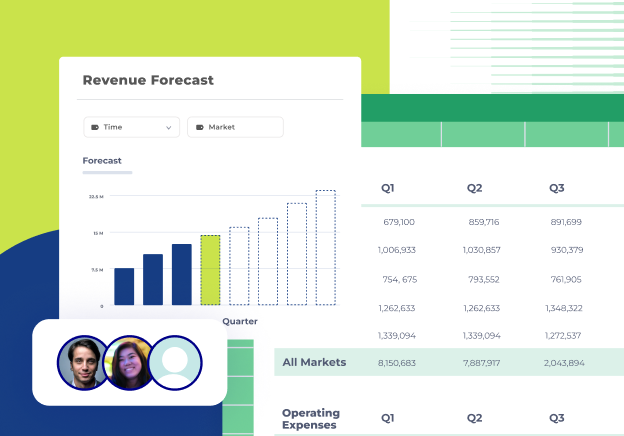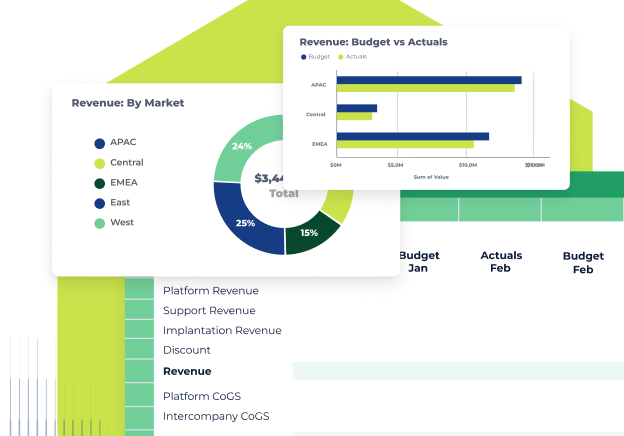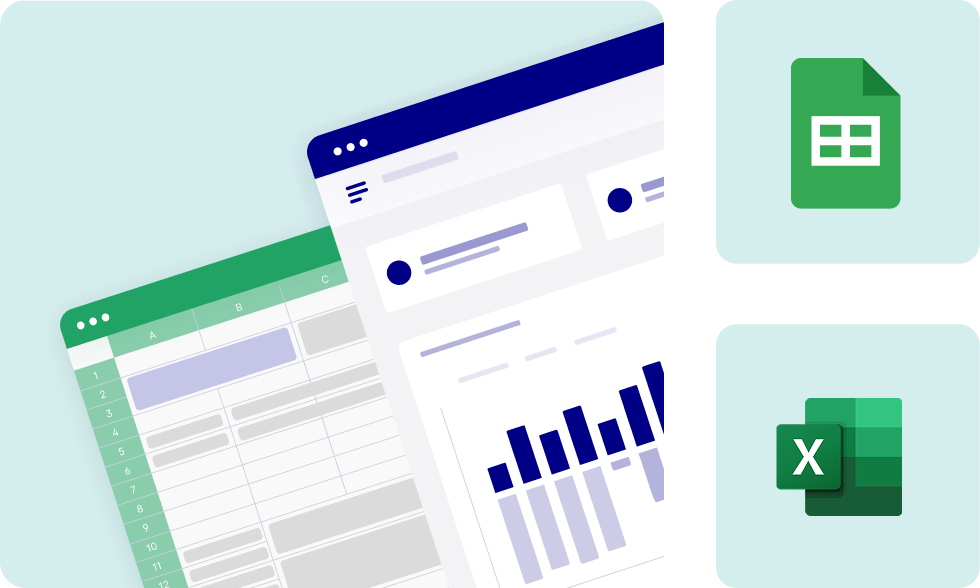What's inside the cash flow statement template
This statement of cash flows template has four simple components:
- Cash Flow (indirect)
- Detailed cash flow (direct)
- P&L (supporting info)
- Balance sheet (supporting info)
Easily input your P&L and your balance sheet into this template. (You can do this in one click if you're a Cube user, FYI.) From there, you can easily calculate and report on your cash flow on a by-month basis.
This template uses both the direct and indirect methods of cash flow.
Complement this template by pairing with our other pro forma templates.
How to use this cash flow spreadsheet
This is an Excel template. You don't need to be a Cube customer to use it! But if you are a Cube user, you can start using this template in under two minutes. Here's how.
Step 1: Open the template in Excel or Sheets.
Step 2: Customize the row and column headers to match your Cube's dimensions and filters.
Step 3: Select the range where you want to fetch your data.
Step 4: Fetch your data.
.gif?width=600&name=CreateTemplate%20(1).gif)
Why choose our statement of cash flows template?
Our user-friendly template is intuitive, making it easy for team members of all skill levels to contribute to your financial planning process. Let’s explore why our tool is the smart solution for your financial management.
Customizable: Our cash flow template is designed with flexibility in mind, allowing you to tailor it to your specific business needs and reporting requirements with ease.
Automated calculations: Optimize your financial reporting process with our template, which automates calculations and consolidates data, saving you valuable time each reporting period.
Straightforward usability: Designed with user experience in mind, our template is accessible to finance professionals and novices alike, ensuring that anyone can use it effectively.
Free to use: Full access to our versatile cash flow template, completely free.
All about the statement of cash flows
The statement of cash flows describes all the cash activities that go in and out of an organization. It also includes cash received from usual operations and investments. There are two major methods for calculating cash flow, although both give you the same end result.
Detailed cash flow (direct) - The direct method determines changes in cash receipts and payments from operations. In other words, it only reflects what's actually happened.
Cash Flow (indirect) - The indirect method takes into account net income and net expenditures in a given period. This means you have to credit and debit your asset and liability accounts respectively to determine the implied cash flow, even if cash has not changed hands yet.
The cash flow formula
Cash flow = Total cash inflows – total cash outflows
This simple equation helps you calculate the net amount of cash generated or used during a specific period. It’s the starting point for understanding your liquidity and navigating financial risk.
Why are cash flow statements important in finance?
Cash flow statements show exactly how cash moves in and out of a business. They focus on cash activity from operations, investments, and financing, helping you see if the company’s liquidity supports both its short-term and long-term goals. This offers valuable insights into a company's financial operations by highlighting the quality of its earnings, which can be inferred by comparing the cash generated from operating activities to the company's net income.
Unlike income statements or balance sheets, cash flow statements offer a real-time view of cash movement. That makes them essential for tracking how efficiently your business is managing its money, not just how profitable it appears on paper.
For finance teams, this visibility is a powerful decision-making tool. You can quickly see whether operations are generating cash or if growth is relying heavily on external funding. These insights guide smarter investment planning, debt management, and cash reserves strategy.
Strong cash flow reporting also builds stakeholder trust. Whether it’s investors, lenders, or board members, clearly showing how your business manages liquidity signals operational discipline and strategic focus. It encapsulates the essence of the adage "cash is king," providing a comprehensive overview of cash movements into and out of the business.
It’s more than a compliance requirement—it’s a signal of financial strength. It serves as a window into the company’s financial efficiency and its ability to sustain itself through its core business activities.
The difference between a cash flow statement and a balance sheet
At a glance, cash flow statements and balance sheets might seem similar—but they tell very different stories.
A cash flow statement tracks how cash enters and exits the business over a set period. It breaks down cash activity into three categories—operating, investing, and financing—giving a detailed look at how money is earned and spent. This makes it essential for understanding liquidity and short-term financial health.
A balance sheet, on the other hand, is a snapshot of the company’s financial position at a specific point in time. It lists assets, liabilities, and equity to show what the company owns, owes, and is worth. It’s useful for long-term analysis but doesn’t reflect day-to-day cash movement.
The key difference between cash flow statements and balance sheets is timing and focus. Cash flow statements are dynamic, tracking movement. Balance sheets are static, showing status. When used together, they give finance teams a full picture, helping leaders make more informed, strategic decisions.
How to create a cash flow statement
Building a cash flow statement is easier than it sounds—especially when you have a template to get started with! Here’s how to create one that accurately tracks how cash moves through your business.
- Choose your reporting period: Decide whether you’re analyzing a month, quarter, or year. Staying consistent with your timeframes makes it easier to spot trends and compare performance over time.
- Start with your opening cash balance: Begin with the amount of cash your business had at the start of the period. This gives you a baseline before any cash movement takes place.
- Categorize your cash flows: Separate all cash activity into three key categories:
- Operating activities: Cash from daily business operations—like sales, payroll, and supplier payments. This shows whether core operations are generating enough cash to sustain the business.
- Investing activities: Cash used for or earned from buying and selling long-term assets like equipment or property. These flows reflect how your business reinvests for growth.
- Financing activities: Cash related to funding your business, such as taking out loans, repaying debt, issuing stock, or paying dividends. This section shows how you support and structure your capital.
- Calculate your ending cash balance: Add the totals from each category to your opening balance. The result is your ending cash balance for the period, giving you a complete picture of how cash moved through the business.
- Review and double-check your work: Accuracy matters. Even small errors can distort your view of liquidity. Use a pre-built template to reduce risk and save time, especially when reporting regularly.
Example cash flow statement spreadsheet
Here’s what a basic cash flow statement looks like in action:

You can use this free cash flow statement template to simplify the process. It’s built to help you organize your data clearly and accurately so you can spend less time formatting and more time on strategic analysis. Whether you're reporting to leadership or reviewing internally, this template is designed to support your workflow.
Download the free cash flow statement by clicking “get my free template” to the right.
Common pitfalls to avoid when using a cash flow statement template
When utilizing a cash flow statement template, it's important to navigate the process with care. This section delves into the typical pitfalls to be mindful of, ensuring your cash flow analysis remains accurate and effective.
Mixing accrual and cash accounting: Ensure all entries reflect cash transactions, not revenues or expenses recognized on an accrual basis.
Double counting: Avoid recording the same transaction in multiple sections, which could distort the cash position.
Ignoring non-cash transactions: Although non-cash activities don't appear in the cash flow statement, they must be reconciled in the notes or supplementary information.
Overlooking bank fees and interest: Small, regular transactions like bank fees or interest payments/receipts should also be included.
Not reconciling with balance sheet and income statement: Ensure the cash flow statement reconciles with changes in the balance sheet and ties back to the net income reported in the income statement.
Additional cash flow statement template resources
We're with you every step of the way. With our extensive library of resources and step-by-step guides,, you'll have all you need to maximize the benefits of your free excel cash flow template.
- Cash flow: What's the difference between the direct vs. indirect method?
- Best cash flow management software tools
- Cash flow forecasting: The financial GPS system
- Create and track a cash budget (step-by-step guide)
Get started with this free cash flow spreadsheet template
Step up your game like the pros with Cube Software's cash flow statement template for Excel. Grab your copy today to simplify, streamline and improve your money management process.
Cash flow statement FAQs
How do you create a cash flow statement?
Creating a cash flow statement starts with choosing a specific time period to analyze, like a month, quarter, or year. Once you've set the timeframe, organize cash activities into three categories—operating, investing, and financing—to provide different aspects of your business's cash movements.
Add up the inflows and outflows for each category to calculate your net cash flow. Then, combine those totals with your opening cash balance to get your ending cash position. Using a template makes this process faster, more accurate, and easier to repeat.
How do you format a cash flow statement in Excel?
To format a cash flow statement in Excel, start by structuring your cash flow statement into three main sections: operating, investing, and financing activities. Use clear headers and list cash inflows and outflows beneath each one like cash received from customers or payments for equipment.
Add formulas to calculate subtotals for each section and total net cash flow and don’t forget to include your opening and ending balances.
For readability, use bold text for totals or conditional formatting to highlight important figures. The goal is to make the statement both accurate and easy to follow.
Make it simple by downloading our free cash flow statement template above.
What are the 5 key items on a cash flow statement?
The core components of a cash flow statement are:
- Cash from operating activities: Day-to-day revenue and expenses
- Cash from investing activities: Buying or selling assets
- Cash from financing activities: Loans, repayments, issuing stock, dividends
- Net cash flow: The sum of all three activity types
- Opening and ending cash balances: Showing where you started and ended the period
Together, they provide a full view of your liquidity and financial health.
What is the best chart for cash flow in Excel?
The best chart for cash flow in Excel depends on what you want to visualize:
- Stacked bar chart: Great for showing how operating, investing, and financing activities contribute to total cash flow
- Line chart: Ideal for tracking cash flow trends over time
- Waterfall chart: Perfect for illustrating how inflows and outflows affect your ending balance step-by-step
Each chart type helps highlight different insights, so choose the one that best fits your audience and reporting goals.
Get started by downloading our free cash flow statement template above.


.png)









.png)
